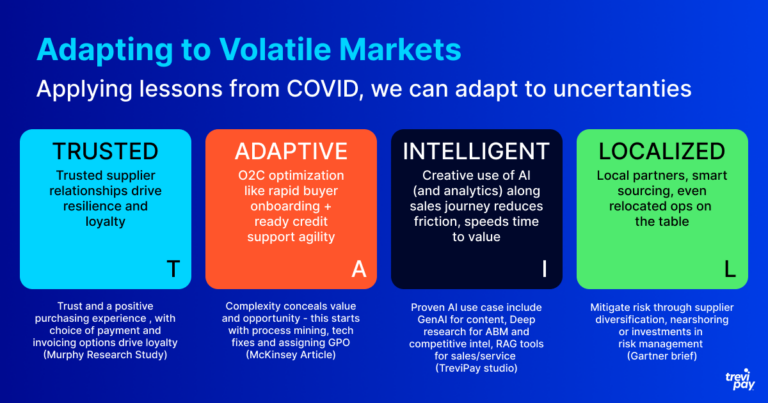Businesses and consumers are surprisingly adaptable. Five years ago, when a pandemic brought the world of trade to a halt, schools and workplaces became virtual, storefronts became distribution centers and new business models emerged. McKinsey observed that in just a few months’ time the COVID crisis accelerated the digitization of customer and supply-chain interactions by three to four years.
At that time, I was leading the digital transformation team at Forrester Research and had a front row seat, as I not only had to adjust to remote work and virtual conferences, but also was part of a new research initiative focused on how companies were adapting to be more “future fit.” A few things were clear. First, the pandemic provided focus and urgency. Second, the lines between B2B and B2C became blurred. Businesses moved much faster to mobile-first experiences and eCommerce. Consumers started to act more like business buyers, valuing product availability and customer service over assortment and low-cost.
In October 2020 I wrote:
“Firms taking a customer-obsessed approach were able to quickly see shifting needs and reconfigure their capabilities to deliver new solutions to market. They were also quick to adjust how they funded and sourced solutions. In short, they had become not just more adaptive but also more creative and resilient, as well.”
Applying Lessons from 2020
With trade wars, nationalism and market volatility back in the headlines, it appears we’ve seen this story before. Sure, some of the actors are different. And the rapid rise of GenAI has added new method actor to the mix. But like the early days of COVID, today’s shifting trade winds are sparking action within large and small enterprises (and governments).
A review of industry research and press reports show that many are revisiting market strategies and strategic partnerships, even while approaches to tariffs are mixed. In sectors like smartphones and computers or luxury autos, there’s been quick action both by governments and manufacturer to adapt or assess the situation. And according to Gartner’s survey of supply chain leaders (CSCOs), while organizations are generally split between eating the cost of tariff increases or passing them on to their customers, almost half say they can regionalize 25% of their supply chain capacity within 12 months.
As in most crises, a quick response to problems and disruptions is vital. A practical example in B2B Payments is credit lines. With tariffs, some of your most important buyers may now be facing an overnight increase in their AOV, so proactively offering to increase their spending limit can both ensure they continue to buy and be an opportunity to build more loyalty.
More broadly, looking back at lessons from COVID, it’s clear both suppliers and corporate buyers who are customer and market “obsessed” will fare better than others. And vendors (and banks) supporting them who have a global footprint can provide more flexibility and adaptability when there are regional disruptions.
Building a Resilient Strategy Starts with Trust
Today’s market environment is both uncertain, but also somewhat predictable. Quick-hit responses will vary – some will work, others will fail. Patterns will emerge and longer-term strategies will result. But we largely have a playbook from previous global market disruptions, whether it was the 2008 financial crisis or COVID. Applying these lessons, leaders can help their teams, clients and partners adapt to the new normal, while also looking for ways to accelerate innovation and even spark transformation projects that may have moved to the back burner.
While individual strategies may vary by geography or industry sector, a review of expert viewpoints and the latest market data (and what worked during COVID) can provide a blueprint for companies to act on today. I have captured some of these insights in the framework below.

First, staying close to your best customers is never a bad thing. Be there for them and they will be with you for the long term. Which is why adapting to (any) volatile market conditions needs to start with trust. Trusted supplier relationships drive resilience. And buyer preference research we conducted with Murphy Research shows that along with choice of payment (80%) and custom invoicing (71%), “trust with supplier” is the top factor (at 90%) in choosing a merchant.
Second, companies that thrive in a time of change are uncommonly adaptive. We saw this in the future fit research at Forrester, and focusing on high-impact stages of the order-to-cash (O2C) process such as more rapid onboarding to accommodate buyers from a new region or “ready credit” for stocking up can both support agility and deliver significant ROI. McKinsey notes that the industrial manufacturer, medical distributor and similar organizations they studied achieved $6 in return for every $1 invested in O2C optimization.
Third, when AI started moving more quickly from the lab to front line applications in the rush to streamline operations and augment human helpers, leaders are looking to be more intelligent across their products and services. Creative use of GenAI and advanced analytics along the sales journey can further reduce friction and speed time to value. Within the marketing function at TreviPay, we are already seeing the impact not only in content marketing, but also for demand gen (for supercharged ABM and list building for example) along with some exciting applications in sales training, meeting prep and even online sales and service.
Finally, as Gartner and others have pointed out, focusing on being localized is essential. Cultivating local partners and smart sourcing should be front and center. And for some sectors, relocating key operations needs to be on the table as well. Mitigating risk through supplier diversification, investment in risk management and strategic growth initiatives and having a trusted, global partner for your O2C optimization has never been more important.







